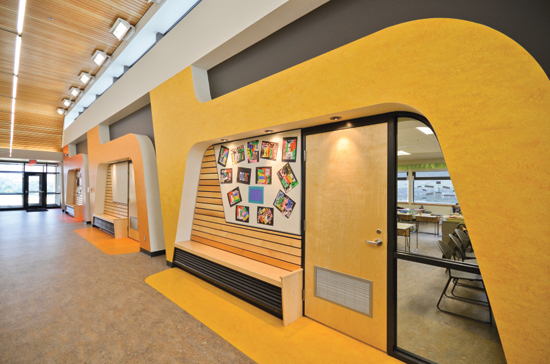Creating Healthy Learning Environments
Designing Healthier Outcomes
In order to illustrate how all of this very good work and information all come together in a real building, we will use flooring as an example by comparing common vinyl flooring with alternatives.
Vinyl Flooring Concerns
Vinyl flooring is made from PVC with associated phthalates as are the adhesives used in its installation and many of the supplies used to clean it. PVC and phthalates have been shown to be considered among the most toxic chemicals in school settings. Further, while it's believed that the “normal” emission of VOCs from vinyl flooring products under standard use and maintenance can pose significant health risks to occupants, recent studies show that the presence of excessive water or heat can further accelerate those emissions and expose occupants to even greater levels of toxicity. For example, the use of lower-quality adhesives and/or outdated application practices can create airspaces and ridges that promote the collection of dirt and water and subsequently foster the growth of dangerous mold and mildew under the surface. In addition, water pooling under impermeable surfaces such as vinyl flooring can potentially pop the flooring, leading to emission of PVC from sub-floor adhesives.
Alternative Flooring Choices
In order to avoid the issues described that are associated with PVC flooring, we can choose flooring and adhesive products that are made from other materials to create healthier learning environments. Specifically, we can look for flooring products that can demonstrate the elimination or a reduction in the use of chemical compounds of concern such as PVC and phthalates. We can also seek flooring systems that produce a reduction in the likelihood of mold and mildew forming, and offer antimicrobial properties that promote infection reduction. The flooring products that meet these preferred criteria are those that use natural materials that have been found to be naturally antimicrobial, mold and mildew resistant, toxin- and biocide-free. A popular and readily available alternative to vinyl that fits this product profile is found in linoleum-based products. Commonly made from 100 percent bio-based and biodegradable ingredients, contemporary linoleum products display health and sustainability advantages for schools. It is also ideal for other school applications including furniture surfaces, walls, and bulletin boards.
In a recent independent test of a natural linoleum-based flooring and adhesive versus another resilient flooring product used with a traditional dry-set adhesive, the linoleum system achieved 100 percent contact between the back of the tile and substrate, creating a water-resistant layer that fully sealed all areas of the backing and filled all cracks and joints. When both tiles were exposed to water, as under a water fountain, the dry-set adhesive used with vinyl tile achieved only 50 percent adhesive contact, producing channels and tunnels that allowed water to travel and pool under the flooring, creating opportunities for the growth of mold and mildew.

Photo courtesy of Forbo Flooring Systems
Selecting materials such as linoleum instead of vinyl flooring helps reduce the presence of PVC and phthalates in school environments, thus reducing the associated health risks.
According to the Asthma Regional Council of New England, among the most critical decisions for schools is the choice of flooring materials that utilize “low-VOC products and flooring surfaces less likely to exacerbate moisture/mold and allergen issues.” By choosing the right flooring product, a quality adhesive that doesn't allow moisture to accumulate under the flooring, and a proper maintenance regime, schools can enjoy safer, healthier, and longer-lasting flooring. Further it avoids the need for toxic finishes and harsh chemical cleaners that are associated with vinyl flooring maintenance. Hence, the cleaning and maintenance of linoleum flooring is healthier and simpler than with vinyl flooring since no toxic, time-consuming, or costly repeated finish and maintenance work is required.

Photo courtesy of Forbo Flooring Systems
Natural, bio-based products can be used on all surfaces of educational environments to help create healthy learning environments.
Cost Comparison
Though vinyl flooring appears to deliver a lower first-cost than other flooring options, the occupancy-ready and total life-cycle cost of vinyl is in fact much higher than others. Healthier, more sustainable alternatives have been found to be more cost-effective to install and maintain. This is due to the expense of the products prescribed to clean, seal, and maintain vinyl flooring from its initial installation through its life, which, ironically, is significantly shorter than other options.
An economic analysis conducted by the University of Florida found that vinyl flooring carries the highest lifetime cost compared to a range of other popular alternatives. Natural, bio-based products are available with a fully guaranteed and occupancy-ready product and installation price on the order of $3.55 per square foot that is more cost-effective to install and maintain over the entire life cycle than other solutions. Further, savings on the order of $1.00 per square foot are possible through the use of lower-maintenance and more environmentally friendly, healthy flooring options. This means 20 percent of the average annual maintenance budget ($5.00 per square foot referenced earlier) could ultimately be redirected to support other critical needs in the care and maintenance of buildings including replacing other materials of concern.
Conclusion
When designing and specifying products and materials to be used in schools, selections can be made based on finding the healthiest choices for students, teachers, and staff. There are an increasing number of data and tools that allow design professionals to investigate and measure the health of an educational environment particularly as it relates to products and ingredients. It is important that we request manufacturers to continue taking steps toward full transparency (and product improvement) by asking for EPDs, HPDs, and USEtox data. In this manner we can confidently replace harmful products with sustainable alternatives. And in the interest of presenting building owners with the best value for their budgets, it is incumbent on us to consider not only initial installation costs, but the cost to maintain the products over its lifetime.
Endnotes
- 1. The Biocidal Products Regulation (EU 528/2012). For more information: http://echa.europa.eu/regulations/biocidal-products-regulation
- 2. “Chemicals and Our Health: Why Recent Science is a Call to Action,” a report published by the Safer Chemicals Healthy Families coalition, for the full report go to www.SaferChemicals.org
- 3. “The Future of Fabric – Health Care”, published by the Healthy Building Network, October 2007 in conjunction with Health Care Without Harm's Research Collaborative.
- 4. http://www.chicagotribune.com/chi-infectiousdiseases-specialpackage,0,2681727.special
- http://www.chicagotribune.com/news/chi-0207210272jul21,0,2177158.story
- 5. Sathyanarayana, S. (2008) Phthalates and children's health. Current Problems In Adolescent Health Care, 38, 34-39. doi:10.1016/j.cppeds.2007.11.001
- 6. “Toxic Chemicals in Building Materials; An Overview for Health Care Organizations” Kaiser Permanent and the Healthy Building Network /Healthcare Without Harm, May, 2008
- 7. Pharos Product Category Descriptions – Resilient Flooring http://www.pharosproject.net/product_category/show/id/3
- 8. America's Children and the Environment, U.S. Environmental Protection Agency, 2008. http://www.saferchemicals.org/resources/health.html
- 9. Holly L. Howe, et al., “Annual Report to the Nation on the Status of Cancer (1973 through 1998), Featuring Cancers with Recent Increasing Trends,” Journal of the National Cancer Institute, 93, no. 11 (June 2001): 824–42. http://www.saferchemicals.org/resources/health.html
- 10. Janet Gray, ed, State of the Evidence: The Connection Between Breast Cancer and the Environment, (San Francisco: Breast Cancer Fund, 2008).
- 11. Tracey J. Woodruff , et al., “Trends in Environmentally Related Childhood Illnesses,” Pediatrics, 113, no. 4 (April 2004): 1133-1140.
- 12. Jeanne E. Moorman, et al., “National Surveillance for Asthma, United States 1980–2004,”Centers for Disease Control and Prevention, www.cdc.gov/mmwr/preview/mmwrhtml/ss5608a1.htm (November 1, 2009).
- 13. Anjani Chandra and Elizabeth Hervey Stephen, “Impaired Fecundity in the United States:1982-1995,” Family Planning Perspectives, 30, no 1, (1998): 34-42.
- 14. Anjani Chandra, et al., “Fertility, Family Planning and Reproductive Health of US Women: Data from the 2002 National Survey of Family Growth,” Vital and Health Statistics, 23, no. 25 (2005).
- 15. Kate Brett, “Fecundity in 2002 National Survey of Family Growth Women 15–24 Years of Age” (personal communication), Hyattsville, MD, National Center for Health Statistics (2008) http://www.womensvoices.org/issues/reports/the-health-case-executive-summary/
- 16. Leonard J. Paulozzi, “International Trends in Rates of Hypospadias and Cryptorchidism,” Environmental Health Perspectives, 107, no. 4, (1999): 297-302.
- 17. National Institute of Mental Health, “NIMH's Response to New Autism Prevalence Estimate,” http://www.nimh.nih.gov/about/updates/2009/nimhs-response-to-new-autism-prevalence-estimate.shtml
- 18. Scientific American “The Baffling Link Between Autism and Vinyl Flooring,” Marla Cone, Environmental Health News 2009
Peter J. Arsenault, FAIA, NCARB, LEED AP, is an architect and green building consultant who has authored over 100 continuing education and technical publications as part of a nationwide practice. www.linkedin.com/in/pjaarch
 |
Forbo Flooring Systems has been creating better environments with its beautiful, durable flooring products for over 100 years. Forbo is committed to complete transparency in its products and the industry, and has included its eco-toxicity and human health and toxicity impacts in the publication of its EPDs in support of full disclosure and transparency. www.forboflooringNA.com |








